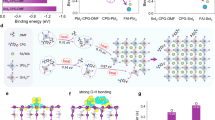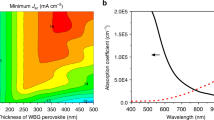Abstract
High-performance perovskite/perovskite tandem solar cells require high-efficiency and stable low-bandgap perovskite subcells. State-of-the-art low-bandgap mixed tin–lead iodide perovskite solar cells exhibit either a high power-conversion efficiency or improved stability, but not both. Here we report a two-step bilayer interdiffusion growth process to simultaneously meet both requirements for formamidinium-based low-bandgap mixed tin–lead iodide perovskite solar cells. The bilayer interdiffusion growth process allows for the formation of high-quality and large-grained perovskite films with only 10 mol% volatile methylammonium. Additionally, one-dimensional pyrrolidinium perovskite was applied to passivate the perovskite film and improve the junction quality, which resulted in a carrier lifetime of 1.1 μs and an open circuit voltage of 0.865 V for our perovskite film and device with a bandgap of 1.28 eV. Our strategies enabled a power-conversion efficiency of 20.4% for low-bandgap perovskite solar cells under AM 1.5G illumination. More importantly, an encapsulated device can retain 92% of its initial efficiency after 450 h of continuous 1 sun illumination.
This is a preview of subscription content, access via your institution
Access options
Access Nature and 54 other Nature Portfolio journals
Get Nature+, our best-value online-access subscription
$29.99 / 30 days
cancel any time
Subscribe to this journal
Receive 12 digital issues and online access to articles
$119.00 per year
only $9.92 per issue
Buy this article
- Purchase on Springer Link
- Instant access to full article PDF
Prices may be subject to local taxes which are calculated during checkout




Similar content being viewed by others
Data availability
All data generated or analysed during this study are included in the published article and its Supplementary Information.
References
Best Research-Cell Efficiency Chart https://www.nrel.gov/pv/cell-efficiency.html (NREL, accessed 25 March 2020).
Shockley, W. & Queisser, H. J. Detailed balance limit of efficiency of p–n junction solar cells. J. Appl. Phys. 32, 510–519 (1961).
Hörantner, M. T. et al. The potential of multijunction perovskite solar cells. ACS Energy Lett. 2, 2506–2513 (2017).
Leijtens, T., Bush, K. A., Prasanna, R. & McGehee, M. D. Opportunities and challenges for tandem solar cells using metal halide perovskite semiconductors. Nat. Energy 3, 828–838 (2018).
Eperon, G. E. et al. Perovskite–perovskite tandem photovoltaics with optimized band gaps. Science 354, 861–865 (2016).
Lin, R. et al. Monolithic all-perovskite tandem solar cells with 24.8% efficiency exploiting comproportionation to suppress Sn(ii) oxidation in precursor ink. Nat. Energy 4, 864–873 (2019).
Tong, J. et al. Carrier lifetimes of >1 μs in Sn–Pb perovskites enable efficient all-perovskite tandem solar cells. Science 364, 475–479 (2019).
Chen, B., Zheng, X., Bai, Y., Padture, N. P. & Huang, J. Progress in tandem solar cells based on hybrid organic–inorganic perovskites. Adv. Energy Mater. 7, 1602400 (2017).
Yang, Z. et al. Enhancing electron diffusion length in narrow-bandgap perovskites for efficient monolithic perovskite tandem solar cells. Nat. Commun. 10, 4498 (2019).
Prasanna, R. et al. Design of low bandgap tin–lead halide perovskite solar cells to achieve thermal, atmospheric and operational stability. Nat. Energy 4, 939–947 (2019).
Leijtens, T. et al. Tin–lead halide perovskites with improved thermal and air stability for efficient all-perovskite tandem solar cells. Sustain. Energy Fuels 2, 2450–2459 (2018).
Kapil, G. et al. Strain relaxation and light management in tin–lead perovskite solar cells to achieve high efficiencies. ACS Energy Lett. 4, 1991–1998 (2019).
Forgács, D. et al. Efficient monolithic perovskite/perovskite tandem solar cells. Adv. Energy Mater. 7, 1602121 (2017).
Wei, M. et al. Combining efficiency and stability in mixed tin–lead perovskite solar cells by capping grains with an ultrathin 2d layer. Adv. Mater. 32, 1907058 (2020).
Wang, C., Song, Z., Li, C., Zhao, D. & Yan, Y. Low‐bandgap mixed tin–lead perovskites and their applications in all‐perovskite tandem solar cells. Adv. Funct. Mater. 29, 1808801 (2019).
Xu, G. et al. Integrating ultrathin bulk–heterojunction organic semiconductor intermediary for high-performance low-bandgap perovskite solar cells with low energy loss. Adv. Funct. Mater. 28, 1804427 (2018).
Liao, W. et al. Fabrication of efficient low-bandgap perovskite solar cells by combining formamidinium tin iodide with methylammonium lead iodide. J. Am. Chem. Soc. 138, 12360–12363 (2016).
Zhao, D. et al. Low-bandgap mixed tin–lead iodide perovskite absorbers with long carrier lifetimes for all-perovskite tandem solar cells. Nat. Energy 2, 17018 (2017).
Zhao, D. et al. Efficient two-terminal all-perovskite tandem solar cells enabled by high-quality low-bandgap absorber layers. Nat. Energy 3, 1093–1100 (2018).
Li, C. et al. Reducing saturation-current density to realize high-efficiency low-bandgap mixed tin–lead halide perovskite solar cells. Adv. Energy Mater. 9, 1803135 (2019).
Li, C. et al. Methylammonium-mediated evolution of mixed-organic-cation perovskite thin films: a dynamic composition-tuning process. Angew. Chem. 56, 7674–7678 (2017).
Tang, S. et al. Composition engineering in doctor-blading of perovskite solar cells. Adv. Energy Mater. 7, 1700302 (2017).
Yang, M. et al. Perovskite ink with wide processing window for scalable high-efficiency solar cells. Nat. Energy 2, 17038 (2017).
Song, Z. et al. Probing the origins of photodegradation in organic–inorganic metal halide perovskites with time-resolved mass spectrometry. Sustain. Energy Fuels 2, 2460–2467 (2018).
Lang, F. et al. Influence of radiation on the properties and the stability of hybrid perovskites. Adv. Mater. 30, 1702905 (2018).
Turren-Cruz, S.-H., Hagfeldt, A. & Saliba, M. Methylammonium-free, high-performance, and stable perovskite solar cells on a planar architecture. Science 362, 449–453 (2018).
Juarez-Perez, E. J. et al. Photodecomposition and thermal decomposition in methylammonium halide lead perovskites and inferred design principles to increase photovoltaic device stability. J. Mater. Chem. A 6, 9604–9612 (2018).
Juarez-Perez, E. J., Ono, L. K. & Qi, Y. Thermal degradation of formamidinium based lead halide perovskites into sym-triazine and hydrogen cyanide observed by coupled thermogravimetry–mass spectrometry analysis. J. Mater. Chem. A 7, 16912–16919 (2019).
Prasanna, R. et al. Band gap tuning via lattice contraction and octahedral tilting in perovskite materials for photovoltaics. J. Am. Chem. Soc. 139, 11117–11124 (2017).
Yu, Y. et al. Improving the performance of formamidinium and cesium lead triiodide perovskite solar cells using lead thiocyanate additives. ChemSusChem 9, 3288–3297 (2016).
Xu, A. F. et al. Pyrrolidinium lead iodide from crystallography: a new perovskite with low bandgap and good water resistance. Chem. Commun. 55, 3251–3253 (2019).
Fan, J. et al. Thermodynamically self-healing 1d–3d hybrid perovskite solar cells. Adv. Energy Mater. 8, 1703421 (2018).
Jiang, Q. et al. Surface passivation of perovskite film for efficient solar cells. Nat. Photon. 13, 460–466 (2019).
Lian, X. et al. Highly efficient Sn/Pb binary perovskite solar cell via precursor engineering: a two-step fabrication process. Adv. Funct. Mater. 29, 1807024 (2019).
Jacobsson, T. J. et al. Unreacted PbI2 as a double-edged sword for enhancing the performance of perovskite solar cells. J. Am. Chem. Soc. 138, 10331–10343 (2016).
Ogomi, Y. et al. CH3NH3SnxPb(1–x)I3 perovskite solar cells covering up to 1060 nm. J. Phys. Chem. Lett. 5, 1004–1011 (2014).
Saliba, M. et al. Incorporation of rubidium cations into perovskite solar cells improves photovoltaic performance. Science 354, 206–209 (2016).
Lee, J.-W. et al. Formamidinium and cesium hybridization for photo- and moisture-stable perovskite solar cell. Adv. Energy Mater. 5, 1501310 (2015).
Yi, C. et al. Entropic stabilization of mixed A-cation ABX3 metal halide perovskites for high performance perovskite solar cells. Energy Environ. Sci. 9, 656–662 (2016).
Saliba, M. et al. Cesium-containing triple cation perovskite solar cells: improved stability, reproducibility and high efficiency. Energy Environ. Sci. 9, 1989–1997 (2016).
Im, J., Stoumpos, C. C., Jin, H., Freeman, A. J. & Kanatzidis, M. G. Antagonism between spin–orbit coupling and steric effects causes anomalous band gap evolution in the perovskite photovoltaic materials CH3NH3Sn1–xPbxI3. J. Phys. Chem. Lett. 6, 3503–3509 (2015).
Hao, F., Stoumpos, C. C., Chang, R. P. & Kanatzidis, M. G. Anomalous band gap behavior in mixed Sn and Pb perovskites enables broadening of absorption spectrum in solar cells. J. Am. Chem. Soc. 136, 8094–8099 (2014).
Harvey, S. P. et al. Mitigating measurement artifacts in TOF–SIMS analysis of perovskite solar cells. ACS Appl. Mater. Interfaces 11, 30911–30918 (2019).
Chen, B., Rudd, P. N., Yang, S., Yuan, Y. & Huang, J. Imperfections and their passivation in halide perovskite solar cells. Chem. Soc. Rev. 48, 3842–3867 (2019).
Yang, W. S. et al. Iodide management in formamidinium–lead–halide-based perovskite layers for efficient solar cells. Science 356, 1376–1379 (2017).
Yin, W.-J., Shi, T. & Yan, Y. Unusual defect physics in CH3NH3PbI3 perovskite solar cell absorber. Appl. Phys. Lett. 104, 063903 (2014).
Khenkin, M. V. et al. Consensus statement for stability assessment and reporting for perovskite photovoltaics based on ISOS procedures. Nat. Energy 5, 35–49 (2020).
Wang, C. et al. Understanding and eliminating hysteresis for highly efficient planar perovskite solar cells. Adv. Energy Mater. 7, 1700414 (2017).
Chen, C. et al. Achieving a high open-circuit voltage in inverted wide-bandgap perovskite solar cells with a graded perovskite homojunction. Nano Energy 61, 141–147 (2019).
Xiao, C. et al. Inhomogeneous doping of perovskite materials by dopants from hole-transport layer. Matter 2, 1–12 (2019).
Jackson, W. B., Amer, N. M., Boccara, A. C. & Fournier, D. Photothermal deflection spectroscopy and detection. Appl. Opt. 20, 1333–1344 (1981).
Acknowledgements
This material is based on work supported by the US Department of Energy’s Office of Energy Efficiency and Renewable Energy (EERE) under the Solar Energy Technologies Office Award no. DE-EE0008753. The TPD-MS study was supported by the National Science Foundation under contract no. DMR-1807818. K.K.S. and R.J.E. were supported by the US Air Force Research Laboratory under agreement no. FA9453-18-2-0037, and N.S., B.S., N.J.P. and R.J.E. were supported by the US Air Force Research Laboratory under agreement no. FA9453-19-C-1002. The US Government is authorized to reproduce and distribute reprints for Governmental purposes notwithstanding any copyright notation thereon.
Author information
Authors and Affiliations
Contributions
C.L., Z.S. and Y.Y. conceived the project. C.L. carried out the single-junction low-bandgap cell and tandem cell fabrication. C.C. prepared the wide-bandgap cell and helped with the tandem cell fabrication. D.L. participated in the wide-bandgap cell fabrication. Z.S. conducted the TPD-MS measurements. C.X. and C.J. helped with the KPFM. B.S. conducted the PDS and SE measurement. S.P.H. conducted the TOF–SIMS measurement. N.S. and K.K.S. helped with the PL and TRPL measurements. L.C. and Y.L. participated in the characterization. Y.-W.K. helped with the 1H NMR measurements. C.L., Z.S. and Y.Y. analysed the data and wrote the manuscript. M.J.H., D.Z., RJ.E., N.J.P. and M.A.-J. helped with the manuscript preparation. All the authors discussed the results and commented on the manuscript. Y.Y. supervised the project.
Corresponding authors
Ethics declarations
Competing interests
The authors declare no competing interests.
Additional information
Publisher’s note Springer Nature remains neutral with regard to jurisdictional claims in published maps and institutional affiliations.
Supplementary information
Supplementary Information
Supplementary Figs. 1–32 and Tables 1 and 2.
Supplementary Data
Statistical source data for Supplementary Figs. 2 and 4, point data, error bars and PDS raw data for Supplementary Figs. 9 and 11b.
Rights and permissions
About this article
Cite this article
Li, C., Song, Z., Chen, C. et al. Low-bandgap mixed tin–lead iodide perovskites with reduced methylammonium for simultaneous enhancement of solar cell efficiency and stability. Nat Energy 5, 768–776 (2020). https://doi.org/10.1038/s41560-020-00692-7
Received:
Accepted:
Published:
Issue Date:
DOI: https://doi.org/10.1038/s41560-020-00692-7
This article is cited by
-
Perovskite–organic tandem solar cells
Nature Reviews Materials (2024)
-
Defect passivation in methylammonium/bromine free inverted perovskite solar cells using charge-modulated molecular bonding
Nature Communications (2024)
-
Heterojunction formed via 3D-to-2D perovskite conversion for photostable wide-bandgap perovskite solar cells
Nature Communications (2023)
-
Aspartate all-in-one doping strategy enables efficient all-perovskite tandems
Nature (2023)
-
Improving interface quality for 1-cm2 all-perovskite tandem solar cells
Nature (2023)



